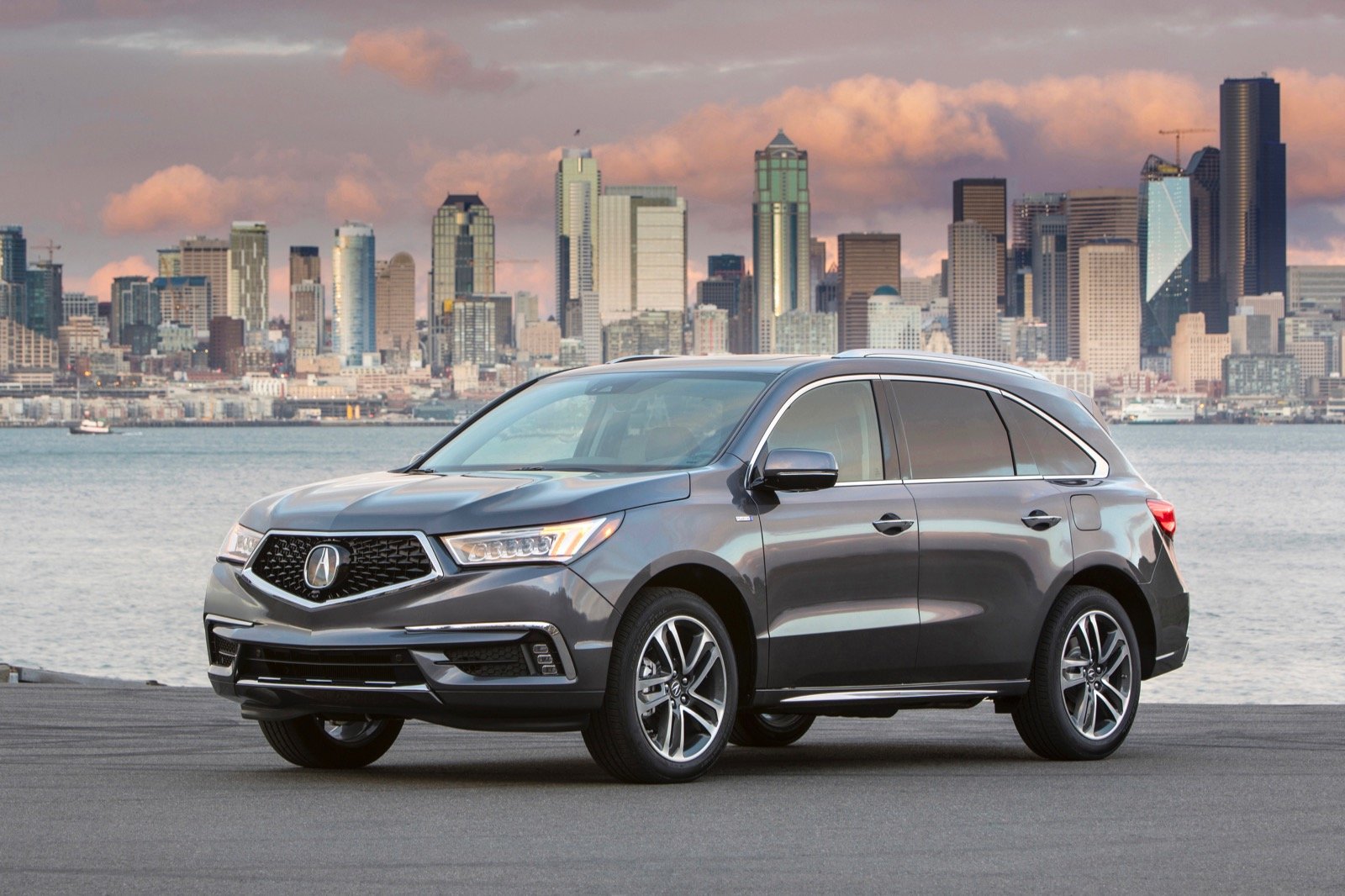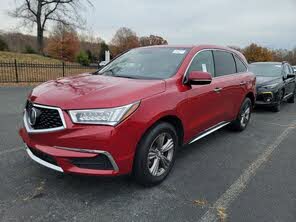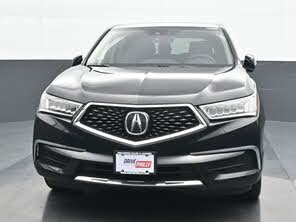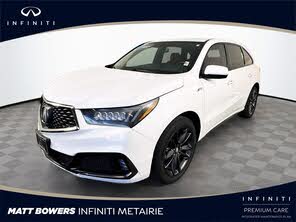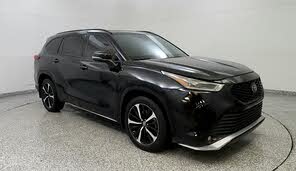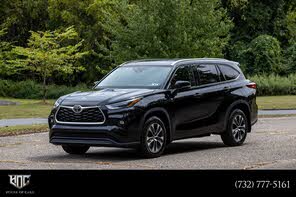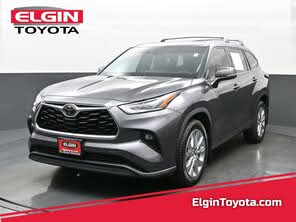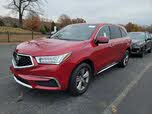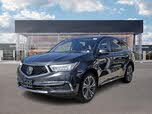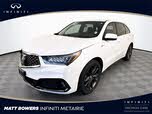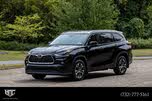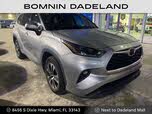2020 Acura MDX vs 2021 Toyota Highlander
Overview | |
MSRP$44,500 | MSRP$35,085 |
Listings607 | Listings1569 |
Ratings & Reviews | |
User Reviews | User Reviews |
Expert reviews7.2 out of 10 | Expert reviews7.5 out of 10 |
Pros
Cons
| Pros
Cons
|
2020 Acura MDX Reviews SummaryThe Acura MDX is the best-selling three-row luxury SUV of all time, with solid performances through three generations of production since 2001. While it may not be an industry leader in any one category, the MDX delivers competitive levels of comfort, convenience, and technology and an attractive overall package that has spawned a loyal repeat audience. | |
2021 Toyota Highlander Reviews SummaryToyota hardly needs any help selling three-row Highlanders. It already sits close to the top of the sales charts for its segment, and few vehicles carry the name recognition as the Highlander, which enters into its 20th year of production. But the three-row marketplace is a competitive one, and even after a 2020 redesign, Toyota would be foolish to rest on its laurels. As such, the Highlander enters this year with additional safety-feature technology listed as standard equipment. | |
No video found | |
Popular Features & Specs | |
Engine3.5L 290 hp V6 | Engine3.5L 295 hp V6 |
Drive TrainFWD | Drive TrainFWD |
Seating Capacity7 | Seating Capacity8 |
Horsepower290 hp @ 6200 rpm | Horsepower295 hp @ 6600 rpm |
MPG City20 | MPG City20 |
MPG Highway27 | MPG Highway28 |
Engine | |
Engine Name3.5L 290 hp V6 | Engine Name3.5L 295 hp V6 |
Torque267 lb-ft @ 4700 rpm | Torque263 lb-ft @ 4700 rpm |
Horsepower290 hp @ 6200 rpm | Horsepower295 hp @ 6600 rpm |
DrivetrainFWD | DrivetrainFWD |
Fuel Economy | |
MPG City20 | MPG City20 |
MPG Highway27 | MPG Highway28 |
Interior | |
Seating Capacity7 | Seating Capacity8 |
Key Features | |
Sunroof/MoonroofStandard | Sunroof/Moonroof |
Safety | |
Front Crash Overall5 | Front Crash Overall4 |
Side Crash Overall5 | Side Crash Overall5 |
Dimensions & Capacity | |
Cargo Space15.0 cu ft | Cargo Space16.0 cu ft |
Curb Weight4032 lbs | Curb Weight4145 lbs |
Height67.4 in | Height68.1 in |
Length196.2 in | Length194.9 in |
Width77.7 in | Width76.0 in |
Wheelbase111.0 in | Wheelbase112.2 in |
Maximum Payload1336 lbs | Maximum Payload1685 lbs |
Number of doors4 | Number of doors4 |
Maximum Towing Capacity3500 lbs | Maximum Towing Capacity5000 lbs |
Overview | ||
MSRP | $44,500 | $35,085 |
Listings | ||
Ratings & Reviews | ||
User reviews | ||
Expert reviews | 7.2 out of 10Read full review | 7.5 out of 10Read full review |
Pros & cons | Pros
Cons
| Pros
Cons
|
Summary | The Acura MDX is the best-selling three-row luxury SUV of all time, with solid performances through three generations of production since 2001. While it may not be an industry leader in any one category, the MDX delivers competitive levels of comfort, convenience, and technology and an attractive overall package that has spawned a loyal repeat audience. | Toyota hardly needs any help selling three-row Highlanders. It already sits close to the top of the sales charts for its segment, and few vehicles carry the name recognition as the Highlander, which enters into its 20th year of production. But the three-row marketplace is a competitive one, and even after a 2020 redesign, Toyota would be foolish to rest on its laurels. As such, the Highlander enters this year with additional safety-feature technology listed as standard equipment. |
Video | No video found | |
Popular Features & Specs | ||
Engine | 3.5L 290 hp V6 | 3.5L 295 hp V6 |
Drive Train | FWD | FWD |
Seating Capacity | 7 | 8 |
Horsepower | 290 hp @ 6200 rpm | 295 hp @ 6600 rpm |
MPG City | 20 | 20 |
MPG Highway | 27 | 28 |
Engine | ||
Engine Name | 3.5L 290 hp V6 | 3.5L 295 hp V6 |
Torque | 267 lb-ft @ 4700 rpm | 263 lb-ft @ 4700 rpm |
Horsepower | 290 hp @ 6200 rpm | 295 hp @ 6600 rpm |
Drivetrain | FWD | FWD |
Fuel Economy | ||
MPG City | 20 | 20 |
MPG Highway | 27 | 28 |
Interior | ||
Seating Capacity | 7 | 8 |
Key Features | ||
Sunroof/Moonroof | Standard | |
Safety | ||
Front Crash Overall | 5 | 4 |
Side Crash Overall | 5 | 5 |
Dimensions & Capacity | ||
Cargo Space | 15.0 cu ft | 16.0 cu ft |
Curb Weight | 4032 lbs | 4145 lbs |
Height | 67.4 in | 68.1 in |
Length | 196.2 in | 194.9 in |
Width | 77.7 in | 76.0 in |
Wheelbase | 111.0 in | 112.2 in |
Maximum Payload | 1336 lbs | 1685 lbs |
Number of doors | 4 | 4 |
Maximum Towing Capacity | 3500 lbs | 5000 lbs |
The 2020 Acura MDX was a good-looking crossover SUV, though few would have called its styling groundbreaking or breathtaking. It was designed to blend in seamlessly rather than turn heads in a crowded parking lot or receive special attention from valets at upscale venues. The vehicle’s styling was fundamentally functional and respectable, fitting nicely without drawing too much attention.
Acura was an early adopter of LED headlights, and its Jewel Eye headlamps added a distinctive touch of class to the MDX’s front end. Unlike traditional incandescent headlights that generally featured one or two lamps per side, the Jewel Eye lights showcased five horizontally arrayed LED elements per side within a housing that also contained the turn signals and daytime running lights. These headlights flanked a trapezoidal grille with a prominent Acura logo, giving the front a uniquely expressive look.
For a three-row SUV, the MDX presented an unusually sleek and low-slung profile, characterized by sharp lines and a fast roofline. The paint and chrome finish always impressed as flawless, underscoring Acura's ongoing commitment to high-quality exterior craftsmanship.
Inside, the MDX featured a modern and straightforward design, eschewing the excessive padding and stitching that were becoming more common in luxury interiors. The center stack stood out, showcasing twin infotainment screens—a high-mounted 8.0-inch LED screen for navigation and an On Demand Multi-Use Display (ODMD) touchscreen below, surrounded by a series of buttons and a prominent command wheel.
The MDX felt decidedly solid and meticulously built, thanks to high-quality materials and superior fit and finish. Control knobs and switches operated with satisfying precision, while the materials offered a rich, tactile experience.
Meanwhile, the 2021 Toyota Highlander was anything but boring. It stood out in a sea of midsize SUVs and crossovers, ready to shuttle children to extracurricular activities with a distinct flair. Its styling captured attention, making it discernible from the competition.
The Highlander featured a less dramatic front end compared to the bullet-train-inspired 2021 Sienna minivan, yet it had its own confident presence with wide headlights, a long hood, and an assertive trapezoidal grille. The side profile blended practicality with sportiness, thanks to a character line reminiscent of the one seen on the Supra sports car. The taillights at the rear, though lacking the vertical element, bore similarity to those on Lexus models, giving a nod to the brand’s superior lineup. These design choices helped the 2021 Highlander appear longer and lower than its predecessor without sacrificing cabin space.
For 2021, the Highlander introduced the XSE trim level, which added a more aggressive front end designed to evoke a “Highlander Sport” feel. This was complemented by suspension tuning and appearance tweaks, including 20-inch wheels with black accents, a mean-looking front fascia, and a larger lower air intake, though it didn't transform the crossover into a high-performance contender.
The Limited trim on our test vehicle, just below the Platinum trim, came with chrome roof rails and accents, making the Highlander look upscale. Inside, it truly shined with near-flawless fit and finish, tan leather seats accented by dark brown trim, and attractive faux wood details. The overall build quality exuded a luxurious feel, devoid of squeaks, rattles, or unsightly gaps.
Comfort took precedence over sportiness in the Highlander, embracing luxury touches like wood details and a meticulously crafted interior. It prioritized the must-have features for family vehicles, ensuring a comfortable and convenient ride for everyone on board.

















The 2020 Acura MDX came with two powertrain options. The first was a naturally aspirated 3.5-liter V6 engine, boasting direct injection and variable valve timing, producing a respectable 290 horsepower and 267 pound-feet of torque. This engine was paired with a nine-speed automatic transmission and offered either front-wheel drive or Acura’s Super-Handling All-Wheel Drive (SH-AWD) system. The second option was the MDX Sport Hybrid, which combined a 3.0-liter V6 gasoline engine with three electric motors, resulting in a combined output of 321 horsepower and 289 pound-feet of torque, managed by a seven-speed dual-clutch automatic transmission (DCT) and all-wheel drive.
During our review, we drove the gasoline-only model equipped with the SH-AWD system. The MDX delivered impressive straight-line performance with quick acceleration and enthusiastic takeoff. The paddle shifters allowed for manual shifting, though the nine-speed automatic transmission was so well-tuned that selecting the correct drive mode (Comfort or Sport) usually sufficed to achieve timely and smooth gear changes.
The MDX’s handling was particularly noteworthy. Thanks to the SH-AWD system with torque-vectoring technology, the vehicle felt unexpectedly nimble around corners. This system distributed power to the outside wheel during cornering, sharpening turns and enhancing overall handling. This feature was especially effective when accelerating from a standstill around a corner, maintaining stability and control without drama or tire squeal.
The MDX’s four-wheel independent suspension adeptly soaked up road imperfections, providing a comfortable and smooth ride, making it an excellent companion for long journeys.
Conversely, the 2021 Toyota Highlander was not designed to deliver thrilling performance. Instead, it prioritized smooth, predictable operation and reliability. The 3.5-liter V6 engine powering the Highlander produced 295 horsepower and 263 pound-feet of torque, paired with an eight-speed automatic transmission. This setup was available with either front-wheel drive or all-wheel drive.
While the Highlander wasn’t built for speed, it offered sufficient power for everyday driving needs, including merging onto highways and handling typical traffic situations comfortably. The V6 engine’s output was comparable to rivals such as the Hyundai Palisade and Kia Telluride, with the Honda Pilot offering slightly more horsepower and the Chevy Traverse slightly less. The Highlander faced tougher competition from the Ford Explorer ST, a more performance-oriented option, though at a higher cost.
The Highlander’s three-row design meant it had a tendency to lumber through corners, a trade-off for its soft and comfortable suspension. This was somewhat mitigated in the XSE trim, which featured tighter suspension tuning, higher-rated springs, retuned shock absorbers, power steering adjustments, and a rear stabilizer bar. These enhancements added a touch of driving excitement without transforming the Highlander into a high-performance vehicle.
Three-row SUVs were increasingly replacing minivans as the preferred choice for families, and the 2020 Acura MDX adopted several functional features from its minivan predecessors. The MDX came with sliding and reclining second-row seats, facilitating easier access to the third row and allowing for adjustable legroom distribution between the two rows. Headroom was adequate across all three seating rows.
The MDX provided 15.8 cubic feet of cargo space behind the third row, which could be expanded to 43.4 cubic feet by folding the third row flat. Additionally, folding down the second-row seats created a spacious 90.9-cubic-foot cargo area with a relatively flat load floor extending to the back of the front seats. Moreover, the vehicle included a recessed cubby hole in the left rear cargo wall and a covered underfloor storage area for concealing items like a briefcase or camera bag.
The front cabin featured a large glove box, a drop-down sunglass holder, a flexible center console with two sizable cupholders, a sliding armrest, and a bin with USB, power, and auxiliary jacks, as well as sufficient space to hold a tablet or small laptop. Water-bottle pockets and additional open storage spaces were integrated into all four door panels. Second-row passengers benefited from cupholders on the back of the center console and storage pouches on the front seatbacks, while third-row passengers enjoyed outboard armrests with built-in storage bins and cupholders.
To ensure optimal comfort, the MDX was equipped with tri-zone climate control, offering individual heating and cooling settings for the driver, front-seat passenger, and rear cabin occupants.
The 2021 Toyota Highlander also prioritized comfort and functionality for three rows of passengers. The vehicle’s interior featured a notable set of shelves ahead of the front seats, suitable for large cell phones, with a pass-through for charging cords to connect to the car's USB ports. Wireless charging pads were standard on trims above the LE, positioned within the center console.
Second-row passengers received sufficient legroom, aided by seats that could slide forward and backward to maximize middle-row space or provide extra legroom to third-row occupants. However, accommodating adults in the third row was feasible only if second-row passengers compromised on some comfort.
Addressing a peculiarity, we noted the placement of rear-seat climate control air vents. Positioned on the ceiling rather than at leg level, they blew air directly onto the middle-row passengers' heads, which might not be the most convenient setup.
Regarding cargo space, the Highlander offered 16 cubic feet behind the third row, enough for minor grocery runs but insufficient for larger loads. Folding the third row expanded the space to 48.4 cubic feet, which was slightly more than what the Honda Pilot offered in a comparable configuration. With both the second and third rows folded down, the Highlander provided an ample 84.3 cubic feet of cargo space, accommodating most needs with ease, though it still fell short compared to minivans.
Acura streamlined the trim levels for the 2020 MDX into various packages, which bundled numerous technology features. The base MDX was well-equipped with standard Siri Eyes Free, Apple CarPlay, Android Auto, hands-free Bluetooth, SMS/MMS text message and email capability, a CD/MP3 and WMA-compatible compact disc player, five USB ports, SiriusXM satellite radio, and an eight-speaker audio system. However, this basic setup lacked some of the more advanced tech extras.
Upgrading to the Technology Package for an additional $5,000 added useful tech enhancements such as rain-sensing windshield wipers, LED puddle lights, front and rear parking sensors, navigation with Acura Real-Time Traffic and Traffic Rerouting, GPS-linked climate control, remote engine start, and an Acura/ELS Studio Premium Audio system with 10 speakers. Further improvements were available with the Advance Package ($6,750), which built on the Technology Package, adding an Active Damper System suspension, LED fog lights, heated and ventilated front seats, power front lumbar support, heated rear outboard seats, a surround-view camera system, Head-Up Warning, and two third-row USB charge ports.
The optional Entertainment Package ($2,000) could be added to either the Technology or Advance Package, featuring a DVD rear entertainment system with a 110-volt power outlet in the front center console and two pairs of wireless headphones. The Advance Package offered a 16.2-inch Ultra-Wide Full VGA screen with HDMI compatibility and two additional speakers, while the Technology Package included a 9.0-inch Full VGA screen and one additional speaker.
The 2021 Toyota Highlander featured an 8-inch touchscreen for trim levels below the Limited trim. Opting for the Limited trim allowed for an upgrade to a 12.3-inch touchscreen, which came standard on the top-tier Platinum trim. These infotainment systems were user-friendly and easy to navigate.
While built-in navigation required an additional payment, its effectiveness varied. It handled specific address searches well but struggled with locating points of interest that Google Maps easily identified. Fortunately, Android Auto and Apple CarPlay were standard across all Highlander trims, providing reliable navigation alternatives.
The 12.3-inch touchscreen in our test vehicle was bright, crisp, and responsive. The associated JBL audio system delivered good sound quality, despite not being particularly groundbreaking. Physical volume and tuning knobs provided convenient control. A notable limitation was that only certain apps took full advantage of the screen’s width; for instance, navigation was restricted to an 8-inch area, prompting questions about the value of the large screen.
The 2020 Acura MDX came with AcuraWatch, a comprehensive suite of passive and active safety features and advanced driver assistance systems. This included adaptive cruise control with low-speed follow, lane-keep assist, forward-collision warning, lane-departure warning, and automatic emergency braking.
For added safety, the Technology Package introduced blind-spot monitoring with rear cross-traffic alert, while the Advance Package included Head-Up Warning. Additional safety equipment encompassed a rearview camera with dynamic guidelines (upgraded to a surround-view camera system in the Advance Package), front airbags, front-side airbags, side curtain airbags with rollover sensors, a driver’s knee airbag, stability control with traction control and motion-adaptive steering, Trailer Stability Assist on all-wheel-drive models, tire pressure monitoring with location and pressure indicators, LATCH child-seat anchors, and a theft-deterrent system with electronic immobilizer.
The MDX’s safety credentials were bolstered by its Next-Generation Advanced Compatibility Engineering (ACE) Body Structure, designed to absorb and redistribute crash energy, protecting occupants. The Insurance Institute for Highway Safety (IIHS) rated the MDX as “good” (its highest rating) in all crash-test categories, “acceptable” for headlights, “superior” for front crash prevention, and “acceptable” for LATCH ease of use. The National Highway Traffic Safety Administration (NHTSA) awarded the MDX a five-star overall safety rating, its highest accolade.
In 2021, Toyota advanced the Highlander’s suite of safety features, upgrading to Toyota Safety Sense 2.5+ (TSS 2.5+). This suite included cutting-edge technologies like automatic emergency braking with pedestrian detection and intersection support, which could recognize potential oncoming vehicles making left turns at intersections and, if necessary, activate automatic emergency braking.
Additional standard features across all Highlander trims encompassed road-sign assist, adaptive cruise control, lane-departure warning, lane-keeping assist, lane-tracing assist, and automatic high beams.
The Highlander’s safety ratings reflected its comprehensive protection offerings. The NHTSA awarded it a perfect five out of five stars, and the IIHS honored it as a Top Safety Pick+.
CarGurus highlights
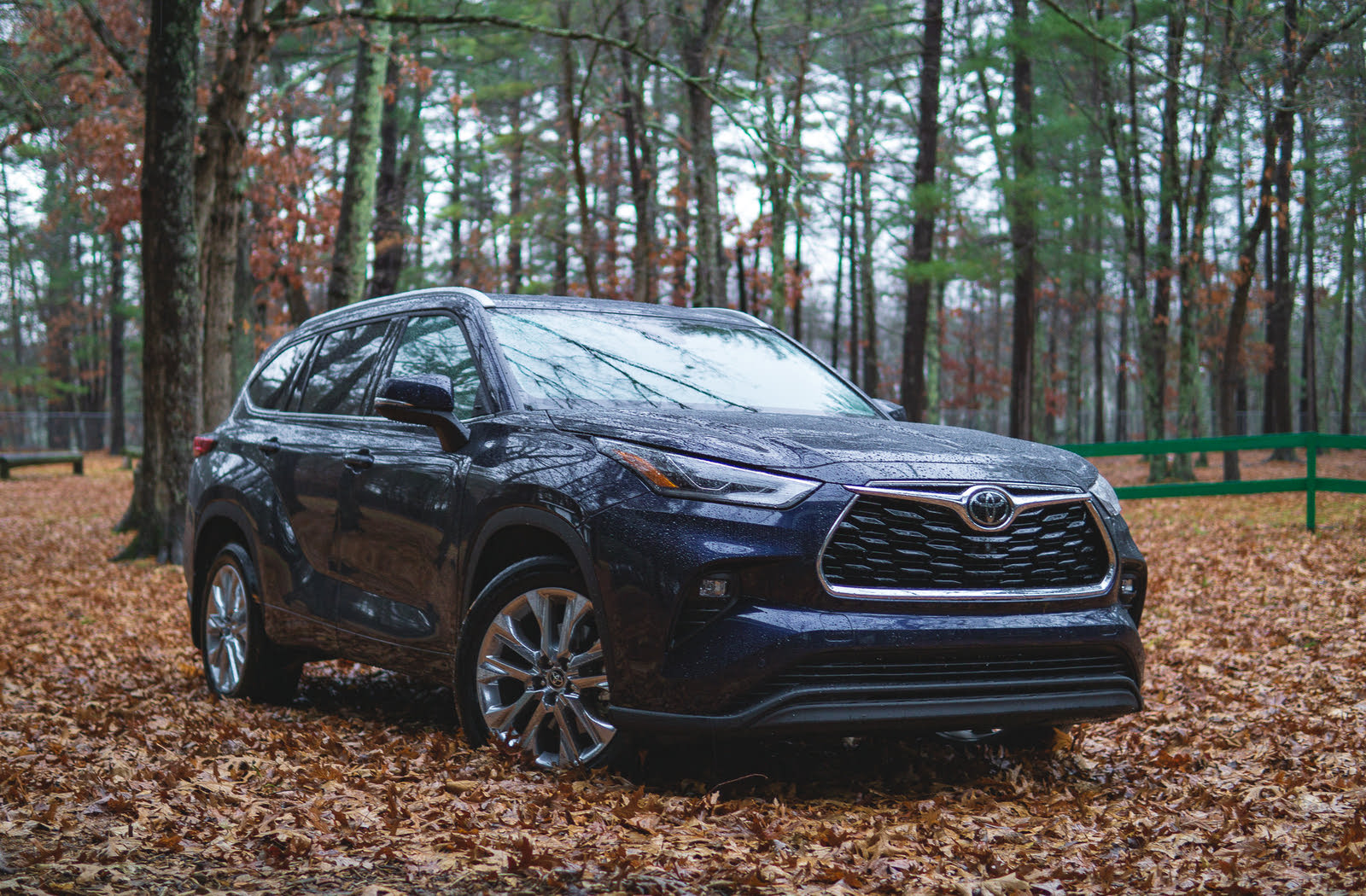
According to CarGurus experts, the overall rating for the 2020 Acura MDX was 7.2 out of 10, while the 2021 Toyota Highlander scored 7.5 out of 10. Despite both vehicles being excellent options in the three-row crossover SUV segment, the 2021 Toyota Highlander takes the crown with a slightly higher rating. It offered a blend of standout styling, spacious and versatile interiors, and a suite of advanced safety features that made it particularly appealing for family-focused shoppers. The Highlander’s superior score makes it the recommended choice when comparing these two vehicles.
Choose the 2020 Acura MDX if:
- You prioritize a sleek, low-slung design with impeccable exterior and interior finishes.
- You desire superior handling and torque-vectoring technology with the SH-AWD system.
- You appreciate a well-equipped vehicle with plenty of tech options, including advanced driver assistance features and multiple infotainment package upgrades.
Choose the 2021 Toyota Highlander if:
- You want a family-friendly crossover with distinctive styling that stands out among midsize SUVs.
- You need a spacious interior with versatile cargo space and comfortable seating for family outings.
- You value a comprehensive suite of advanced safety features, including Toyota Safety Sense 2.5+, without compromising on reliability and practicality.
CarGurus highlights

According to CarGurus experts, the overall rating for the 2020 Acura MDX was 7.2 out of 10, while the 2021 Toyota Highlander scored 7.5 out of 10. Despite both vehicles being excellent options in the three-row crossover SUV segment, the 2021 Toyota Highlander takes the crown with a slightly higher rating. It offered a blend of standout styling, spacious and versatile interiors, and a suite of advanced safety features that made it particularly appealing for family-focused shoppers. The Highlander’s superior score makes it the recommended choice when comparing these two vehicles.
Choose the 2020 Acura MDX if:
Shop Now- You prioritize a sleek, low-slung design with impeccable exterior and interior finishes.
- You desire superior handling and torque-vectoring technology with the SH-AWD system.
- You appreciate a well-equipped vehicle with plenty of tech options, including advanced driver assistance features and multiple infotainment package upgrades.
Choose the 2021 Toyota Highlander if:
Shop Now- You want a family-friendly crossover with distinctive styling that stands out among midsize SUVs.
- You need a spacious interior with versatile cargo space and comfortable seating for family outings.
- You value a comprehensive suite of advanced safety features, including Toyota Safety Sense 2.5+, without compromising on reliability and practicality.

By: CarGurus + AI
At CarGurus, our team of experienced automotive writers remain at the heart of our content operation, conducting hands-on car tests and writing insightful guides that are backed by years of industry experience. To complement this, we are harnessing AI to make our content offering more diverse and more helpful to shoppers than ever. To achieve this, our AI systems are based exclusively on CarGurus content, ratings and data, so that what we produce is both unique to CarGurus, and uniquely helpful to car shoppers.
